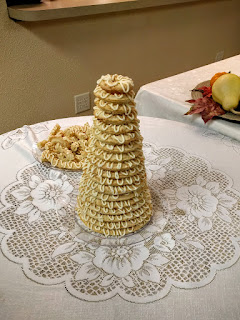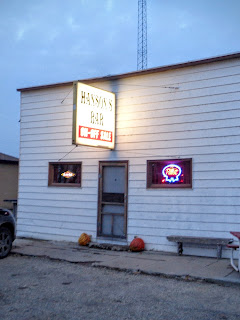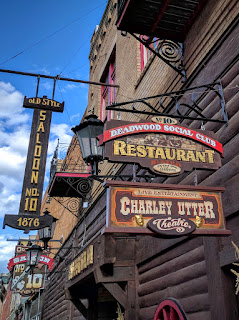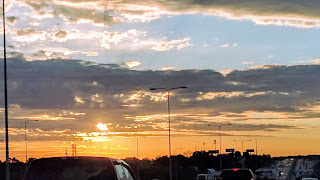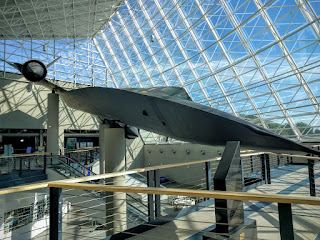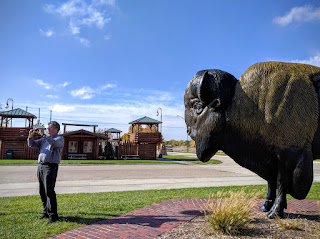1. North Dakota has a remarkable collection of giant animals, including Dakota Thunder (a bison), Sandy (a sandhill crane), and Salem Sue, the world's biggest Holstein.
2. A boom in oil production in the northwest portion of the state helped weather the recession of the early 21st century. However, water protectors are concerned about contamination of the Missouri River. They and others concerned about desecration of Native land are protesting the construction of a pipeline through the state.
3. Beginning in the late 1800s and into the 20th century, North Dakota was a popular destination for immigrant farmers and laborers from Norway, Sweden, Germany, and the United Kingdom. In 2009, almost half the state's population was of German descent, while 30% had Norwegian ancestry.
4. North Dakota had the highest churchgoing population of any state as of 2006.
5. 90% of the land area is farms, and most of the grain grown has been for animal feed.
6. It's the least visited of the 50 states and doesn't have a major tourist attraction. The state slogan is (wait for it!) "Legendary."
Every week through the end of 2018, we'll be walking into a bar somewhere in the United States to find out what makes a good bar (and a good church). Sit at the bar with us!
Monday, October 31, 2016
Saturday, October 29, 2016
We Walk into a Bar in North Dakota
“You aren’t from Rugby, are you?” Mark, one of the owners, asked. He had been outside with most of the bar’s customers experimenting with a small pumpkin cannon that wasn’t quite working. Most people assumed we were hunters passing through the area, because that’s who most visitors to Robinson are this time of year. But there was the possibility we could be rivals from the north.
It’s an understandable concern. Hanson’s Bar and the small town of Robinson, North Dakota, are in the midst of a battle of sorts with the city of Rugby, ND. This dispute will probably go on for awhile, since it began decades ago.
Many of us battle to be the center of attention, but this battle is for the right to be known as the center of North America. Hanson’s Bar has evidence for its place on the continent. Right in the middle of the bar floor there’s a sticker that reads, “Geographic Center of North America.” Of course, Rugby has competing evidence: a 21 foot rock obelisk with those same words on a plaque. But Robinson has one thing that Rugby doesn’t have any more -- A trademark from the U.S. government for the title of “Geographic Center.”
Rugby used to have that trademark, which they purchased in 1932. But about twenty years ago, they let the trademark lapse. And this past year Robinson took advantage of that mistake, raised the necessary $350, and bought the trademark for themselves. Of course, the good people of Hanson’s Bar claim there’s more than government paperwork involved in the issue. There’s also “science.”
I talked to Junior, a long time patron of the bar, who said “with global warming and the shift of the polar ice caps the geographic center has shifted south.” That’s what most anyone in the bar will tell you. It’s their story and they’re sticking with it.
This battle for the center has been in the news, and that’s what drew us to Hanson’s Bar. But it’s not the only thing. Hanson’s Facebook page was up to date, and recent posts let us know that the place has a sense of humor -- always an attractive quality.
From the Facebook page, we knew that this weekend is Hanson’s 2nd Annual Giant Pumpkin Contest. According to the page, “Weigh-off will start around 4 or 5 or 6, or whenever we get our s**t together, with destruction via explosion shortly after just south of the bar.” We almost got to see a bit of that explosive action, but the cannon wasn’t quite in working order yet. Mark assured us it would be functioning come Saturday.
Mark said they try to have an event at the bar at least once a month. In July it was a truck and tractor pull, and in February or March there is a Fish Fry to enjoy the haul of local ice fishers. The biggest day may be Danny Hanson Day, celebrating the man who owned the bar until he passed away several years ago. (He was the perfect bartender, we were told, always in a chipper mood. “Everybody knew Danny.”) After his death, the bar closed, but eventually locals put enough money together to buy the building and open the place up again with joint ownership.
Mark is one of those owners, though he insisted he’s just “a visitor because I’ve only been here ten years.” He said he’s just the guy who spins the records. (And he did take obvious delight in his collection of LPs and turntable, changing records frequently and taking requests.)
I asked him our two questions, “What makes for a good bar?” and “What makes for a good church?” and he combined the two answers into one. “It’s all about the people,” he said. “Both are places for people to come together. I don’t consider this a bar; it’s Robinson’s community center. When it rains, people come in from north and south to compare what was in their rain gauges.”
I talked to Junior, who was sitting next to me at the bar. He’s a native to Robinson, and he took over his father’s farm, which he’s worked now for over fifty years. When he graduated from the local high school, there were 67 students in attendance. The elementary school was the last school in town to close; eight years ago, its last year, there were only two students. Any students now must commute to Steele, about twenty miles away.
Junior said he’s seen many farmers in the community go bankrupt over the years. “They see corn prices go up, and they overextend themselves buying property and equipment, and then the prices go down and they can’t make it.” Junior owns his land free and clear and says, “I haven’t got rich, but I’ve done okay.”
I asked Junior what makes for a good bar. He said it was about “the person running it, if he has a good personality. He’ll come and talk to you. I’ve seen bartenders that serve you and then stand in a corner by themselves.” He had good things to say about Mark. “He was out today helping Danny move his barn.”
Junior is a churchgoer, and his answer for what makes for a good church was similar to his answer for what makes for a good bar. “I like a pastor who has a good personality and will have a beer with you. Many won’t.” I asked him why he thought some pastors wouldn’t join in for a drink and he said, “I don’t know, maybe they think the Lord said they shouldn’t.” He spoke well of a Lutheran pastor who “used to come in and drink with us. He was one of the guys and he brought in a lot of young people to the church.”
Mindy asked our two questions of Jay, another farmer at the bar. “I never thought about [what makes for a good bar,] he said. “Probably in small towns, the local characters. This one is probably no different from others. Small ones like this are more like a cafe. Instead of a cup of coffee, you get a can of beer.” As for church, Jay said he hadn’t been to church for quite a few years, even though he belongs to one. He said there weren’t many people at his church, but “they’re strong in the community. They help with money and stuff. Churches like the one we’ve got are good, apart from me not going. It’s just the community. They support the local businesses like the bar, I guess.”
Mark and Jay talked for awhile about ways the bar and the community were intertwined, recalling a number of times when, after a funeral, the family had asked that the bar be opened. Mourners had food at the hall across the street, then gathered at the bar. They told Mindy, “you only see some of your cousins at funerals,” and that old classmates and other people coming in from out of town appreciated a place to gather.
Jay mentioned that it was nice to have the bar as a central point for the area. “You farm, you want to know what’s going on with farms ten miles north. When you farm, what you do when you’re 70, 38, or at 21 is the same. You kind of have the same job. In a small town, ages don’t matter. When you farm, the things you do don’t change. You can relate to all farmers.” He added, “In a small town, you can’t pick your friends. You live here, so you have liking that life in common.”
Mark wasn’t the only person behind the bar. He was pretty much chatting and spinning wax while Courtney was taking care of the drinks. When she had a moment, I asked her what makes for a good bar, “Um, for me, a relaxed atmosphere, good selection, and friendly people.” I asked what made for a good selection and she said, “More than five kinds of beer. And more than beer.”
I asked Courtney what would make for a good church. “Personally, I was raised in the church, but I don’t go anymore. The church kicked me out because I didn’t look right.” (I was momentarily confused by what about Courtney’s appearance would lead to her being ejected from the church. Then I realized it might be her tattoos, and she confirmed that was the case.) “Churches need to understand there’s more than one way to be a Christian.” I asked if there was anything she missed about not being in a church, and she said it was “the sense of community.”
We were about to leave, but then Mark introduced us to two hunters, Rich and Glen from Pennsylvania. We took the opportunity to ask them about bars and churches.
Rich said that what makes for a good bar is “Cold beer, no smoke, and friendly people.” He said that bars back home are trendy now, and for him, “trendy means ‘don’t bother.’” As for church, he looks for friendly people. “I do go to church, but not for the usual reasons. If I didn’t go to church, by Monday I’d be strangling people. The Word has a placating effect.” And he added, “I believe in Jesus,” perhaps unsure if we did as well.
Monday, October 24, 2016
6 South Dakota Facts to Learn
1. The state's official nickname is "The Mount Rushmore State." The motto is "Under God the people rule."
2. The eastern part of the state is more like the Midwest; the western portion is considered part of the Great Plains. The Missouri River is the dividing line.
3. Black Elk Peak in the Black Hills is not only the state's highest point, it's the highest point (at 7,242 feet above sea level) east of the Rocky Mountains.
4. Five of South Dakota's counties are completely within sovereign Indian reservations.
5. Mount Rushmore was established as a national memorial in 1925 (the monument was completed sixteen years later).
6. When the interstate highway system was completed in the 1960s, the Black Hills region was established as a tourist destination.
2. The eastern part of the state is more like the Midwest; the western portion is considered part of the Great Plains. The Missouri River is the dividing line.
3. Black Elk Peak in the Black Hills is not only the state's highest point, it's the highest point (at 7,242 feet above sea level) east of the Rocky Mountains.
4. Five of South Dakota's counties are completely within sovereign Indian reservations.
5. Mount Rushmore was established as a national memorial in 1925 (the monument was completed sixteen years later).
6. When the interstate highway system was completed in the 1960s, the Black Hills region was established as a tourist destination.
Saturday, October 22, 2016
We Walk into a Bar in South Dakota
“You have to read people,” Melody said, “You figure out if they want things straight or if they’re just looking for a good story.” Melody has a lot of opportunities to tell stories as a bartender at the Saloon #10 in Deadwood, South Dakota. The Western legend Wild Bill Hickok was famously assassinated while playing poker at Saloon #10. So is this the saloon where Wild Bill was killed? Well, what do you want: the truth or a fun tall tale?
Melody said that daytime at the No. 10 Saloon is tourist time. During high tourist season, the summer, there are numerous shows throughout the day in the bar featuring a “Wild Bill,” including shootouts. Even the day we were there, a Tuesday in October, there was one afternoon show in No. 10.
No. 10 is like many of the other bars in town; there are also card tables and slot machines (including a Sex in the City slot machine, just like Wild Bill Hickok used to play.)
Melody told us some of the stories she likes to tell tourists. “Wild Bill used to sit in that chair by the fireplace. I’m not making any promises, but some people have taken pictures of that spot and had unexplainable ghostly images appear in their photos.” One day, an elderly woman entered the bar and pointed at Melody and screamed, “Liar! Liar! The stories you told me not true!”
Of course they weren’t true. It doesn’t take much effort to walk around town and read the historical markers that state that Hickok was killed in 1876 and the original No. 10 Saloon was burned down in a fire in 1879. And it was across the street. But as the reporter explains in the great John Ford western, The Man Who Shot Liberty Valance, “When the legend becomes fact, print the legend.”
We looked inside the saloon in the afternoon while the Wild Bill show was going, but we came back later in the evening. We sat at the bar next to a man who told us he was a local, even though he was wearing a Giants cap (the National League playoffs were on the TV, and he was quite obviously rooting for the Cubs against the Dodgers). Mindy ordered an Apple Ale and I asked for Rum and Coke and an order of onion rings.
We introduced ourselves, and he told us his name was Jake. He used to live in California, in Orangevale near Sacramento, but while still young he and his mom moved back to her hometown of Deadwood. When we asked what he looked for in a bar, he said he likes this place, “This is my hometown bar.” He said people know him here, and that when he comes in, they know he’ll be ordering a Morgan’s and Coke. He told us he works at a bar down the street, but that it’s not where he hangs out. He likes the bands that No. 10 brings in about four nights a week, though not the night we were there. He said that we’d come on movie night. (The original Texas Chainsaw Massacre was going to be the evening’s feature. Children are allowed in the bar in the daytime, but it is exclusively for those over 21 after 8:30 pm.)
We asked, as we usually do, what would make for a good church and Jake said he had no opinion; it wasn’t his thing. But he did say that when they’d returned to the area, his mother began to attend the Catholic Church again. The main reason for her return to church, he said, was so when she died, she could be buried in the local Catholic graveyard with her relatives.
We were also able to ask Melody, our bartender, what she thought made for a good bar. She said that friendliness is good. Good drink prices per pour. She said staff is important to set the mood, and that the bartender should be a “feisty person who can do some back and forth with the customers; a little sassy.”
Another bartender, Lia, joined the conversation and agreed about the importance of sassiness. Lia and Melody talked a bit about how that attitude was helpful in dealing with people who had a bit too much to drink. Both bartenders discussed having to deal with customers who made advances. There is a delicate balance between turning down those advances without being mean or losing business.
All three, Jake, Melody, and Lia, prefer their bars to be a little darker, a little closer to a dive bar. (Jake said that the bar he worked at was a little too well lit.) They said that a dive bar allowed people to be themselves. At a stuffy, well-lit place, people might well be judging you.
Lia said a good bartender knows when customers want attention and when they want to be left alone. She said years of bartending should earn a person a degree in therapy, and Melody agreed.
I asked what made for a good church. Melody said, “Nonjudgemental is a big one for me.” People shouldn’t go into a place and feel out of place for being a sinner. She said it helps “to at least have a buddy to go with.” She said that she doesn’t make it to church because she and her boyfriend sleep too late on Sundays.
Lia does go to church, and in fact teaches Sunday School. She goes to a small church that she describes as nonjudgmental. “It took me a long time to find a church that was okay with tattoos.” She also appreciates that her church has a good time of socializing before the service begins, and then everyone goes in at once. The service is only an hour, which she appreciates, and she said that worship services are supplemented by “life groups” that meet during the week. “I’ve got people to go to church with me because I work at a bar, that might not have gone otherwise.”
On our way out we stopped to chat with Nathan, who was keeping an eye on the door. He only recently began doing security -- usually he bartends as well. (During the summer, between the kitchen, the card tables, the bar, the restaurant, and more, about 130 people are on staff at No. 10. During the off season, it’s closer to 80.)
We asked Nathan what he thought made for a good bar. “Good bartenders. Do you need three things? No? Just good bartenders; nice, but don’t take any crap. Oh, and clean restrooms.” We haven’t had anyone mention clean restrooms before, but we’ve been to places that have reminded us how important that feature is.
We asked Nathan what would make for a good church, and he said, “I don’t know, I’m not really religious. I guess an enthusiastic and entertaining pastor. It’s all about the people.” When I pointed out the similarity between that answer and his response about bartenders and bars he said, “The experience is all about the people you meet.”
I asked Nathan whether there were an times that were especially difficult for security at the bar. He said that there were a number of weekends where the town allowed people to carry open containers in town (one of those weekends, Deadweird, a Halloween celebration, is coming up). Those times tend to bring out the worst in some people. He was okay with that though, “Deadwood knows how to have a good time.”
He had more good things to say about No. 10. He noted that most of the employees had worked there for over 5 years, so they must be doing something right. The bar also raised a lot of money for charity, over $100,000 the previous year. One of those charity projects was for a local police officer’s daughter who has cancer. The bar raised $22,000 in one day to help pay for her treatment.
To quote from the writer Thomas Sowell, “When you want to help people, you tell them the truth. When you want to help yourself, you tell them what they want to hear.” As is probably true for most tourist destinations, the staff at No. 10 Saloon does a little of both. We enjoyed both the tall tales and the truth they had to share.
Monday, October 17, 2016
6 Ways You Didn't Know Nebraska is Unique
1. Three sites in the state claim to be "Where the West Begins:" the intersection of 13th and O Streets in Lincoln; Chimney Rock; and the spot where the 100th meridian runs through Cozad.
2. As of April 2015, the state's unemployment rate was 2.5%, the lowest in the nation.
3. Kool-Aid, which was created in Hastings, is the official soft drink of Nebraska.
4. Nebraska is the only state with a unicameral legislature. The legislature is officially non-partisan, so state senators are elected without listing a party affiliation.
5. Strategic Air Command and Aerospace Museum, outside Omaha, preserves Cold War and aerospace artifacts in inspiring educational exhibits (the gift shop's nice, too).
6. The Kearney Archway crosses Interstate 80 near the midpoint of the freeway as it crosses the state. Interactive exhibits inside and out honor the history of the people involved in the American westward movement.
2. As of April 2015, the state's unemployment rate was 2.5%, the lowest in the nation.
3. Kool-Aid, which was created in Hastings, is the official soft drink of Nebraska.
4. Nebraska is the only state with a unicameral legislature. The legislature is officially non-partisan, so state senators are elected without listing a party affiliation.
5. Strategic Air Command and Aerospace Museum, outside Omaha, preserves Cold War and aerospace artifacts in inspiring educational exhibits (the gift shop's nice, too).
6. The Kearney Archway crosses Interstate 80 near the midpoint of the freeway as it crosses the state. Interactive exhibits inside and out honor the history of the people involved in the American westward movement.
Saturday, October 15, 2016
We Walk into a Bar in Nebraska
Nite Owl, Omaha
“I hear when they opened this place, they had a large screen and were trying to decide whether to use in for sports. But there are so many sports bars already. I ‘m glad they decided to use the screen for movies. Because I don’t like sports but I like movies.” Deborah was explaining why she liked the Nite Owl, our bar for Nebraska.
The film playing that day was Labyrinth, the Jim Henson cult favorite that features a young Jennifer Connelly along with David Bowie and a multitude of Muppets not named Kermit. Deborah said she’d never seen the whole film before, so she’d finally get to see the end of it that day. The Nite Owl plays cult films, things like The Goonies or The Big Lebowski (and one would hope, Buckaroo Banzai: Across the 8th Dimension).
There also is a place for cult art in the Nite Owl, with fine displays of black velvet paintings. And, of course, there are owls on display in the Night Owl.
You might assume that we went to the Nite Owl at night, because that would make good sense. After all, the place is open Monday through Saturday until 3 AM. Monica, one of the bartenders, told us that we would see “interesting people” later in the evening. But the happy hour is early, and I wanted to order the Totchos, tater tots with Mexican seasoning (I ordered a Birdhouse Slider as well.)
Mindy and I ordered the cocktails on tap; I had the El Gringo and she ordered the Black Berry Gin and Tonic. (They also have PBR for $2.00 during happy hour, but we’d have to be paid a lot more than $2.00 to drink a Pabst Blue Ribbon. Or pretty much any other beer)
I saw a number of young people needing to show their I.D.s. When they ordered (No, they did not ask for our I.D.s.). We found the people -- both employees and patrons -- at the Nite Owl to be quite friendly, so we had no problem finding people to ask answer our two weekly questions, “What makes for a good bar?” and “Whether you go or not, what makes for a good church?”
Jose, a bartender, said, “Many things go into making a good bar, but three of those things would be atmosphere, the people, and the drinks.” I asked him to be more specific about those three things. For atmosphere he said, “You should feel cozy and yet it should be fun. It should be intriguing and yet still welcoming.” For people: “By people I mean the staff and the customers. They should be friendly and welcoming.” As for drinks, he said, “There needs to be an eclectic selections, there should be cheap beer and nice beer, there should be cheap cocktails and high quality cocktails.” He had a hard time with what makes for a good church, “I don’t know. I don’t go.” But eventually he said what would make it a good church would be “acceptance.”
Another bartender, Monica, said a good bar has a good ambience, good cocktails, and friendly bartenders. She said it should be comfortable and not corporate looking; “it should be eclectic, unique,” she said, with a nod to the Nite Owl’s decor. As for what makes a good church, she values diversity. She thinks a church should be open minded and accepting of the gay community as well as of different races and ages.
Mindy spoke to one other bartender who took over when Monica’s shift ended (because we really like bartenders), Gunnar. He said he likes a bar with atmosphere, which for him means “having a place where you’re comfortable. Good drinks help!” When Mindy asked about a church, he said St. Margaret Mary’s is the only church he’s been to. He said he appreciates a church with dark wood, which he thinks feels cozy and “so dark you could go to sleep, and your mother won’t see you.” He appreciates a church with beautiful architecture.
We talked to customers as well. Earlier, I mentioned Deborah, a young woman at the bar with her friend, Irene. They both said the Nite Owl is their favorite bar.
“This is our bar,” Irene said. When asked what makes this a good bar, she spoke highly of the cocktails. She said it was okay for a bar to have a drink or two for “guys” like Bud Lite, but only a drink or two. This is where Deborah shared her appreciation for the movies at the Nite Owl. In response to what would make for a good church, Deborah said, “Comfy pews and good wine.”
Irene recommended a church from her home town, the First Baptist Church of Plattsmouth. She said the people there were quite friendly.
Shortly after we’d ordered, a young woman entered and went to the spot at the bar where people could orders things to go. She had a few minutes to wait, so I asked if she’d mind answering a few questions, and she pulled up a chair.
Sorry, Nite Owl, Candice did not name you as her favorite bar. She said her favorite place down the street was “more of a brewery.” When asked what she likes about the place, she said, “They remember my name. They know what I’m going to order, I don’t have to ask.” And she said they have very good beer, which they make. We talked a bit about bars and she said that bars are different at different times, but especially in Nebraska on Game Day (there is really only one Game Day, she said, and that’s when the Cornhuskers are playing). Then Candice would rather not be at a bar, but at someone’s house with friends. She’s not a football fan, but enjoys socializing during a game.
I asked Candice what would make for a good church, “I don’t know. They should serve beer. I’d probably go if they served beer. It might attract people.” I knew she was joking to a degree, but I asked her more about it. She said she’d been to a variety of churches; her parents were divorced and she’d had to go to different churches back in her youth. “Ugggggh,” was her feeling about the churches in those days. But she said, “I’d feel that a church that served beer was accepting. Everywhere should serve beer.”
We spent more time talking to Candice about her job and school, but then she realized the fries she had ordered to go were getting cold. Candice had said she like going to bars because she liked talking to people. I very much enjoyed talking to Candice.
One of the downsides to a new bar in a new state every week is that we are unlikely to see again the friends we meet. But I’m still very glad to have met Candice and the other folks at the Nite Owl.
Subscribe to:
Posts (Atom)
